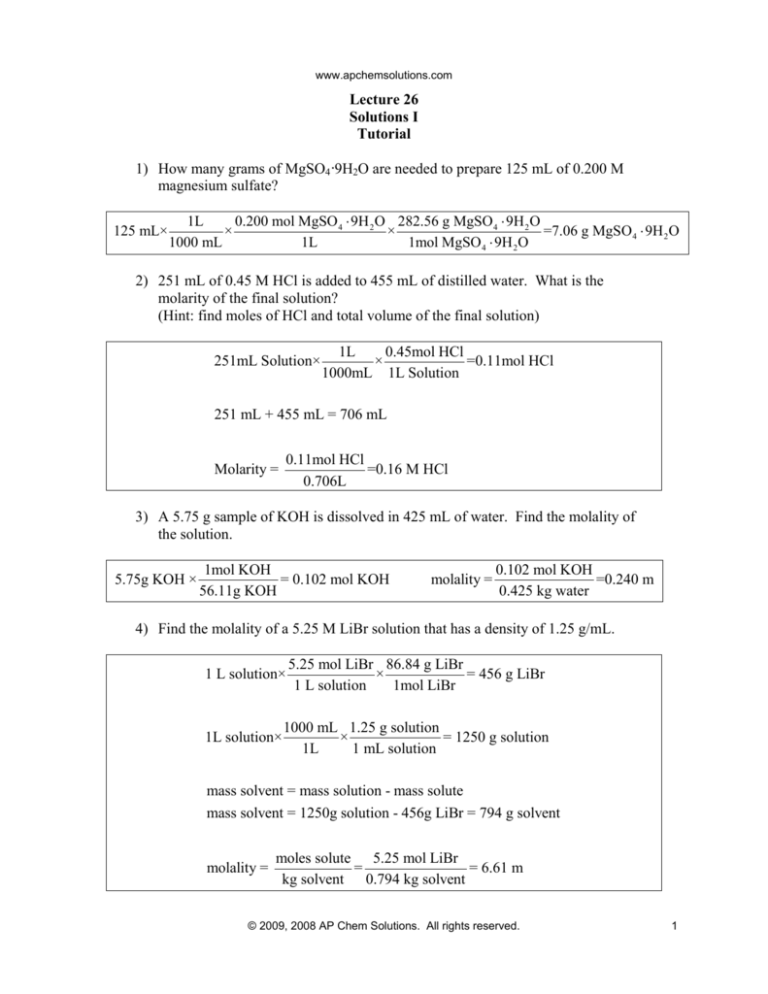
www.apchemsolutions.com
Lecture 26
Solutions I
Tutorial
1) How many grams of MgSO4·9H2O are needed to prepare 125 mL of 0.200 M
magnesium sulfate?
125 mL×
1L
0.200 mol MgSO 4 ⋅ 9H 2 O 282.56 g MgSO 4 ⋅ 9H 2 O
×
×
=7.06 g MgSO 4 ⋅ 9H 2 O
1000 mL
1L
1mol MgSO 4 ⋅ 9H 2 O
2) 251 mL of 0.45 M HCl is added to 455 mL of distilled water. What is the
molarity of the final solution?
(Hint: find moles of HCl and total volume of the final solution)
251mL Solution×
1L
0.45mol HCl
×
=0.11mol HCl
1000mL 1L Solution
251 mL + 455 mL = 706 mL
Molarity =
0.11mol HCl
=0.16 M HCl
0.706L
3) A 5.75 g sample of KOH is dissolved in 425 mL of water. Find the molality of
the solution.
5.75g KOH ×
1mol KOH
= 0.102 mol KOH
56.11g KOH
molality =
0.102 mol KOH
=0.240 m
0.425 kg water
4) Find the molality of a 5.25 M LiBr solution that has a density of 1.25 g/mL.
1 L solution×
1L solution×
5.25 mol LiBr 86.84 g LiBr
×
= 456 g LiBr
1 L solution
1mol LiBr
1000 mL 1.25 g solution
×
= 1250 g solution
1L
1 mL solution
mass solvent = mass solution - mass solute
mass solvent = 1250g solution - 456g LiBr = 794 g solvent
molality =
moles solute 5.25 mol LiBr
=
= 6.61 m
kg solvent 0.794 kg solvent
© 2009, 2008 AP Chem Solutions. All rights reserved.
1
www.apchemsolutions.com
5) Find the mole fraction of glucose, C6H12O6, in a 2.1 m solution of glucose and
water.
molality =
2.1 mol C6 H12 O6
1 kg H 2 O
1000 g H 2 O×
X C6 H12O6 =
1 mol H 2 O
=55.49 mol H 2 O
18.02 g H 2 O
nC6 H12O6
nC6 H12O6 + nH2O
=
2.1 mol
= 0.036
2.1 mol + 55.49 mol
6) A 0.452 g sample of an unknown compound is dissolved in 8.543 g of water.
Find the molar mass of the unknown compound if the molality of the solution was
found to be 0.524 m.
mol solute
kg solvent
mol solute = ( molality )(kg solvent) = 0.524m × 0.008543 kg = 0.00448 mol
molality =
MM =
0.452 g
mass
=
= 101 g/mol
moles 0.00448 mol
7) 200 mL of 2.0 M copper (I) nitrate is mixed with 150 mL of 2.5 M sodium
chloride. The mixture produces a precipitate.
a. Identify the precipitate.
CuCl(s)
b. What is the limiting reactant? Justify your answer.
Cu + ( aq ) + Cl− ( aq ) → CuCl( s )
200 mL×
150 mL×
1L
2.0 mol Cu + 1 mol CuCl
×
×
= 0.40 mol CuCl
1000 mL
1L
1 mol Cu +
1L
2.5 mol Cl- 1 mol CuCl
×
×
= 0.38mol CuCl
1000 mL
1L
1 mol Cl-
NaCl or Cl− is the limiting reactant as it will produce less CuCl.
© 2009, 2008 AP Chem Solutions. All rights reserved.
2
www.apchemsolutions.com
c. What is the maximum mass of precipitate that can be formed in this
reaction?
0.38 mol CuCl×
99.00 g CuCl
=38 g CuCl
1 mol CuCl
d. What is the percent yield if 31 g of precipitate is formed in the reaction?
actual yield
×100
theory yield
31 g
% yield =
× 100 = 82%
38 g
% yield =
e. The percentage yield increases when the temperature of the solution is
reduced. Explain why this is.
The solubility of CuCl decreases as temperature decreases. Thus, at lower temperatures,
more precipitate will form.
8) Describe the process for making a saturated solution of sugar and water.
To do this, you must keep the solution at a constant temperature. Keep adding sugar and
stirring until the sugar will no longer dissolve. When the solution has dissolved as much
sugar as it can, and excess solid sugar remains on the bottom of the container, the
solution is saturated.
© 2009, 2008 AP Chem Solutions. All rights reserved.
3









